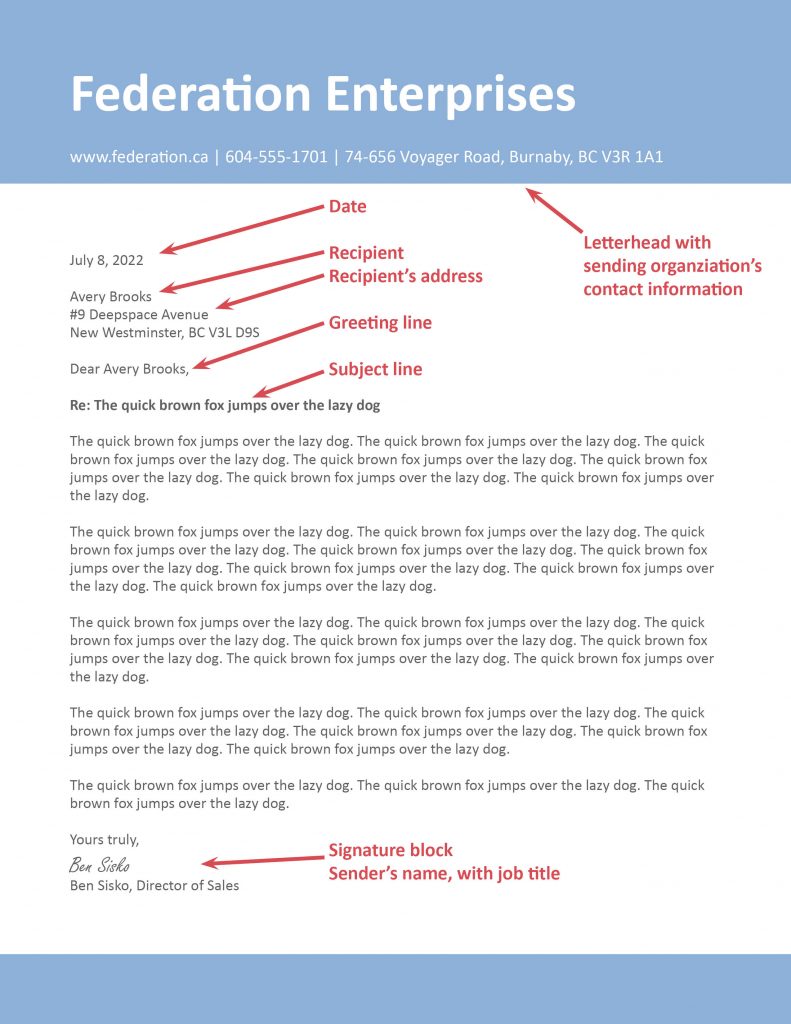Professional Correspondence
20 Professional Letters
Letters are brief messages sent to recipients that are often outside the organization (i.e., external). They are often printed on letterhead, which includes the organization’s logo and contact information, and they are usually limited to one or two pages. While email and text messages may be used more frequently today, the business letter remains an important medium for professional communication.
Letters are the most formal format for business correspondence and your credibility will be established by using a formal tone and a conventional format for the document.
Use a letter format for communicating with people outside of your own organization or for information that will be kept on file (such as an offer of employment) or may be needed for legal proceedings (such as a disciplinary letter). Your reader will expect a well written and well formatted document. The full block letter format is the most straightforward letter format. Professionals who produce their own correspondence using this format will appreciate its simplicity and consistency.

The full block letter format
A typical letter has nine main elements, which make up the full block letter format:
- Letterhead/logo: sender’s name and return address
- Date: the date the letter was written
- Recipient’s address block: name the recipient(s), often including their job title and organization (not pictured above), plus the mailing address
- Salutation: “Dear ______ ” use the recipient’s name (or a substitute if not known)
- Subject line: an indication of the subject of the letter (usually begins “Re” with a colon)
- The introduction: establishes the overall purpose of the letter
- The body: articulates the details of the message
- The conclusion: includes a call to action and indicates next steps
- The signature block: includes the signature of the sender (sometimes omitted in digital documents), the name of the sender, and usually their job title
You can see how these elements are implemented in the example above. Keep in mind that letters represent you and/or and your company. In order to communicate effectively and project a positive image, remember these guidelines:
- Your language should be clear, concise, specific, and respectful.
- Each word should contribute to your purpose.
- Each paragraph should focus on one idea.
- The parts of the letter should form a complete message.
- The letter should be free of errors.
Note that, in legal matters, letters are often hand delivered; this is done to verify that the receiver has received the letter and that can be presented with certainty in court.
For broadcast letters, as in form letters from businesses or fundraising letters, where hundreds, thousands, or even millions of people are receiving the same letter, except for their name and contact information, names and address blocks can be left blank or coded with fields. That allows the user to merge a list of contacts (names and addresses) from a database with the form letter to create personalized form letters. MS Word has a feature called “Mail Merge” that performs this task well and allows as many fields as the writer would like. For example, for a fundraising letter, the amount being requested could be customized to be slightly more than the donor’s most recent donation in an attempt to push their contributions slightly higher.
Attributions
This chapter was adapted from Effective Professional Communication: A Rhetorical Approach by Rebekah Bennetch, Corey Owen, and Zachary Keesey, which is licensed under a Creative Commons Attribution-NonCommercial-ShareAlike 4.0 International License, except where otherwise noted.
Bennetch, Owen, and Keesey adapted their chapter from “Technical Writing Essentials” by Suzan Last (on BCcampus). It is licensed under Creative Commons Attribution-ShareAlike 4.0 International License.
a quality that allows others to trust and believe you

